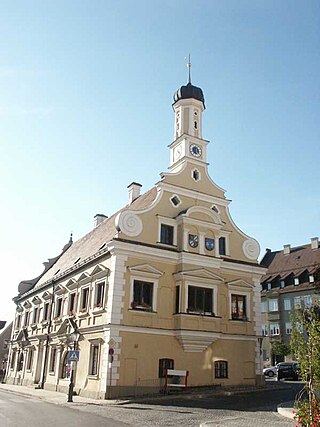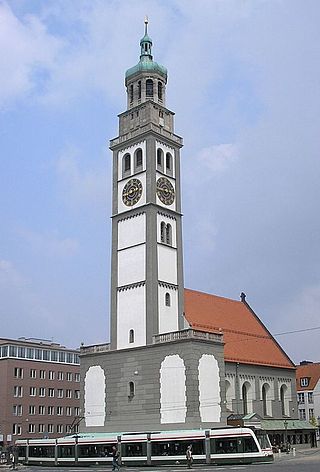
Augsburg is a city in the Bavarian part of Swabia, Germany, around 50 kilometres (31 mi) west of the Bavarian capital Munich. It is a university town and the regional seat of the Regierungsbezirk Swabia with an impressive Altstadt. Augsburg is an urban district and home to the institutions of the Landkreis Augsburg. It is the third-largest city in Bavaria, with a population of 304,000 and 885,000 in its metropolitan area.

Friedberg is a town in the district Aichach-Friedberg, Bavaria, Germany, with some 30,000 inhabitants. It is located next to Augsburg at the river Lech. The town was founded in the 13th century in order to collect a toll from people using the bridge across the Lech.

Alte Oper is a concert hall in Frankfurt am Main, Hesse, Germany. It is located in the inner city, Innenstadt, within the banking district Bankenviertel. Today's Alte Oper was built in 1880 as the city's opera house, which was destroyed by bombs in 1944. It was rebuilt in the 1970s as a concert hall with a large hall and smaller venues, opened in 1981. The square in front of the building is still known as Opernplatz.

The Königsberg Castle was one of the landmarks of the East Prussian capital Königsberg, Germany.

Johann Peter Theodor Janssen was a German historical painter.

Munich-Pasing is a railway station in the west of Munich. It is the third-largest station in the city, after München Hauptbahnhof and München Ost.

Elias Holl was the most important architect of late German Renaissance architecture.

The 70-metre-tall Perlachturm is a belltower in front of the church of St. Peter am Perlach in the central district of Augsburg, Germany. It originated as a watchtower in the 10th century. The existing Renaissance structure was built in the 1610s by Elias Holl, who also designed the neighbouring Town Hall.

Augsburg Town Hall is the administrative centre of Augsburg, Bavaria, Germany, and one of the most significant secular buildings of the Renaissance style north of the Alps. It was designed and built by Elias Holl, Stadtbaumeister, in 1615–1624. Due to its historic and cultural importance, it is protected by the Hague Convention for the Protection of Cultural Property in the Event of Armed Conflict.

St. Anne's Church in Augsburg, Germany, is a medieval church building that was originally part of a monastery built in 1321. It is notable for its elaborate interior decoration.

The Gau Westphalia-North was an administrative division of Nazi Germany encompassing the Free State of Lippe, the Free State of Schaumburg-Lippe and the northern half of the Prussian province of Westphalia between 1933 and 1945. From 1931 to 1933, it was the regional subdivision of the Nazi Party for these areas.
Alabama-Halle was a concert and theatre venue in Munich, Germany, which was also used to broadcast the television programme Live aus dem Alabama. It was originally part of a military depot.
Timeline of Augsburg, Bavaria, Germany.
Wolfgang Plath was a German musicologist specialising in research on Wolfgang Amadeus Mozart.

The Willibaldsburg is a spur castle, built around the year 1353, in Eichstätt in Upper Bavaria. Until the middle of the 18th century, it was the representative castle and seat of Eichstätt's prince-bishops.

The Staatstheater Augsburg is a theatre of Augsburg, Germany. Until 1999 it was called Städtische Bühnen Augsburg, from then until the end of August 2018 it was called Theater Augsburg. It offers on four stages musical theatre, plays and ballet, with its own choir and the orchestra Augsburg Philharmonic.

Wolfgang Händler was a German mathematician, pioneering computer scientist and professor at Leibniz University Hannover and University of Erlangen–Nuremberg known for his work on automata theory, parallel computing, artificial intelligence, man-machine interfaces and computer graphics.
Heinz Hubert Baumann was a German Roman-Catholic priest in Aachen.

The Kulturhistorische Museum Magdeburg(KHM) is a museum in Magdeburg for Cultural History. It was originally founded in 1906 as an art-historically oriented Kaiser-Friedrich Museum. The museum focuses on the history of the city in permanent and special exhibitions. Art-historical pieces are also presented. The Museum für Naturkunde Magdeburg is also located in the same building.

The Old Town Hall, which dominates the east side of the Markt square in Leipzig's district Mitte, is considered one of Germany's most important secular Renaissance buildings. At the rear is the Naschmarkt. The mayor and the municipal administration have been housed in the New Town Hall since 1905.
This page is based on this
Wikipedia article Text is available under the
CC BY-SA 4.0 license; additional terms may apply.
Images, videos and audio are available under their respective licenses.

















